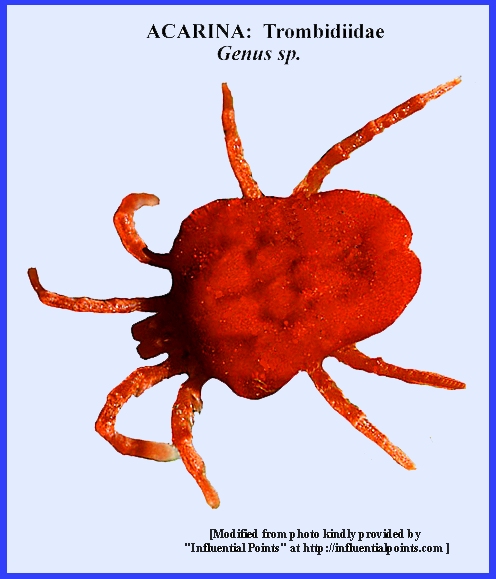File: <trombidoidea.htm> <Medical
Index> <General Index> Site Description Glossary <Navigate to Home>
|
TROMBIDOIDEA (Chiggers) (Contact) Please
CLICK on
Image & underlined links to view:
Although there are a
number of families, only one, the Trombidiidae, is of medical importance
because the larvae are parasitic on humans and animals. Other families do have parasitic species,
which are of minor importance. The subfamily Trombiculinae includes the
"harvest" and "chigger mites." They are conspicuous by their brilliant coloration. The widely known chigger, Entrombicula
alfreddugesii (Oudemanus),
is a pest of humans in North America.
Typically in Trombidoidea, the larvae of this species are very tiny
(e.g., E. batatas) and
adhere to blades of grass in wild areas, from which they can transfer in
large numbers to persons walking by.
Then they become larger as they feed on body fluids, and eventually
they drop to the ground to reproduce.
The itching and subsequent scratching around the feeding sites can
result in severe infections. OTHER IMPORTANT SPECIES Eutrombicula batatas (L.) is the "patatta
mite" of South and Central America and the Caribbean. The life cycle
differs slightly in the tropical environment. Trombicula autumnalis
(Shaw) attacks animals and humans in Europe, where severe skin inflammation
can result. In the Far East Trombicula
akamushi (Brumpt) is the cause of "Japanese River Fever." Trombicula
deiiensis Walch of the East Indies attacks animals and
humans. Trombicula fletcheri W. & H. attacks humans in New
Guinea. Many other unidentified
species of Trombicula and other
genera attack humans in the South Pacific. LIFE CYCLE (See Diagram) Trombiculid mites have a complex life cycle and different
terms have been applied to the developmental stages, but the terminology used
by Service (2008) is applied as follows:
Adults of this group are not parasitic but rather inhabit the soil
where they feed on other arthropods.
During warm weather a female mite may lay up to five eggs daily on
organic material located on the soil surface, in field grasses, etc. "Deutorum" larvae with six legs
emerge but initially do not leave the egg shell (the
"Deutovum"). Activity
begins about a week later when the mites swarm all over the soil and
grasses. They try to attach to
mammals and birds as well as to people with which they come into
contact. They gather around soft and
moist areas of a host. The larvae then penetrate into the skin, injecting saliva
that destroys cells. They feed on
lymphal fluid instead of blood. The continued
release of saliva then results a nasty skin reaction. Some species spend a whole month on a
host, but the vectors of Scrub Typhus remain on a host for only
about a week. When fully fed the
larvae exit the host and drop to the ground where they bury into the soil or
under leaf litter, etc. There they
change into a "Protonymph," which moults within week and gives rise
to a "Deutonymph" with eight legs.
The deutonymphs like the adults feed for a couple of weeks on
arthropods in the soil. Feeding stops
and the nymphs change into a "tritonymph" that moults after about
two weeks giving rise to the adult stage.
The total life cycle generally takes up to two months, but sometimes
8-10 months are required. Because nymphs and adults feed on other arthropods they require
habitats where there are sufficient arthropods present to sustain them. Service (2008) noted that ideal habitats
are often produced when vegetation is cleared for agriculture or wood
products. DISEASE ASSOCIATIONS The mites can cause severe itching, which often leads to
infections in humans. But some
species are vectors of disease. Tstsugamushi Disease caused by a virus
was first found in Japan where it is also known as "Japanese River Fever," but it is
now widespread in Asia and Australasia
The virus, Rickettsia orientalis, is transmitted by the bite
of the red mite, Trombicula akamushi,
and a local rodent serves as a reservoir of the virus. Incubation in humans is 7-14 days and
mortality often follows, especially in older people. CONTROL Severe cases of infestation should always require the
attention of a physician, but as with other groups of pestiferous mites
avoidance of infested areas and the use of available repellants is
advisable. Control of breeding sites
in the environment may also be applied to reduce mite infestations. These sites exist as islands in the
vegetation where mites can be reduced by burning or insecticide application. = = = = = = = = = = = = = = = = = =
= =
Key References: <medvet.ref.htm> [Additional references may be found at: MELVYL Library] Azad, A. F. 1986. Mites
of public health importance and their control. WHO/VBC/86.931. Geneva, Switzerland Conradt, S. A., T.
J. Corbet, E. J. Roper& J. Bodsworth 2002. Parasitism by the
mite Trombidium breei on four
U.K. butterfly species. Ecological Entomology 27(6): 651-659. Matheson, R. 1950. Medical Entomology. Comstock Publ. Co, Inc. 610 p. Makol, Joanna 2007.
Generic level review and phylogeny of Trombidiidae and Podothrombiidae
(Acari: Actinotrichida: Trombidioidea) of the world. Annales Zoologici 57(1):
1-194 Oudhia, P. 1999.
Traditional medicinal knowledge about red velvet mite Trombidium sp. (Acari: trombidiidae in
Chhattisgarh. Insect Environment 5(3): 113 Service, M. 2008.
Medical Entomology For Students.
Cambridge Univ. Press. 289 p Zhang,
Zhi-Qiang. 1998. Biology
and ecology of trombidiid mites (Acari: Trombidioidea). Experimental & Applied Acarology 22:
139-155. |
